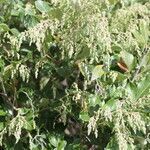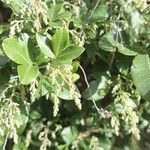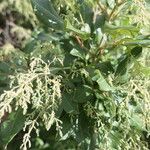Branches puberulous or glabrous; leaves petiolate; leaflets elliptic or ovate, acute, or acuminated at both ends, entire or coarsely serrated from the middle to the apex, smoothish above, whitish-tomentose beneath; panicles terminal, downy, longer than the leaves; drupe depressed, globose, pubescent. A shrub or tree, height of trunk 2-3 feet, diameter 3-4 inches. Branches somewhat patent, branchlets brownish-purple. Leaflets green and costate above, ribbed below, quite entire or with 3-6 teeth, the lateral ones smaller, the terminal 1.5-2 inches long, 1-1(1/4) inch wide, in var. B. 1.5-2.5 inches long, 6-8 lines wide. Common petiole 0.5-1 inch or longer, sub-terete; petiolules in var. a. very short or wanting, in var. B. 3-6 lines long. Panicles mostly terminal, elongated; flowers minute. Fruit the size of a small pea.
Tree or shrub, 0.5-5.0 m high, much branched; bark grey-brown, smooth; branches reddish brown, glabrous to tomentose, ridged, lenticels tiny. Leaves petiolate, trifoliolate; leaflets petiolulate, coriaceous, dark grey-green and glabrous to pubescent above, creamy canescent and lanate below, widely lanceolate, elliptic or obovate, margins slightly thickened, entire or grossly pauciserrate in upper 2/3. Inflorescence in lax, much-branched panicles, glabrous or pubescent, axillary or terminal; males up to 90 mm long, scented, exposed; females up to 50 mm long, within foliage. Flowers: calyx pubescent. Flowering time Jan.-Oct. Fruit a drupe, oblate, ellipsoid, creamy canescent.
A shrub or small tree. It grows up to 5 m tall. It has many branches. The bark is smooth and grey-brown. The branches have shallow ridges. They have red hairs when young. Older branches are green. The leaves are alternate and have 3 leaflets. The leaflets are 3-9 cm long by 1-4 cm wide. The end leaflet is the largest. They taper to the base. The flowers are in branched groups in the axils of leaves or at the ends of branches. Male and female flowers are on separate plants. The fruit is round and fleshy. It is 4-6 mm long by 3-4 mm wide. It has a grey covering.
Much-branched shrub or small tree, up to 5 m high. Leaflets petiolulate; usually 1.5-3.0 x longer than broad, discolorous, dark grey-green and glabrous to thinly pubescent above, creamy canescent and villous tomentose to lanate below; terminal leaflet (29-)49(-79) x (8-)22(-45) mm; petiolules 3-5 mm long. Flowers: corolla dull yellow; Sep.-Jun. Fruits ellipsoid, pubescent.
Much-branched shrub or small tree, up to 5 m high. Leaflets usually 1.5-3.0 times longer than broad, discolorous, dark grey-green and glabrous to thinly pubescent above, creamy canescent and villous-tomentose to lanate below. Flowers dull yellow.
Dioecious, evergreen shrub or small tree to 6 m. Leaves trifoliolate, leaflets stalked, obovate, discolorous, often toothed. Flowers cream-coloured. Drupes ellipsoid, hairy.




